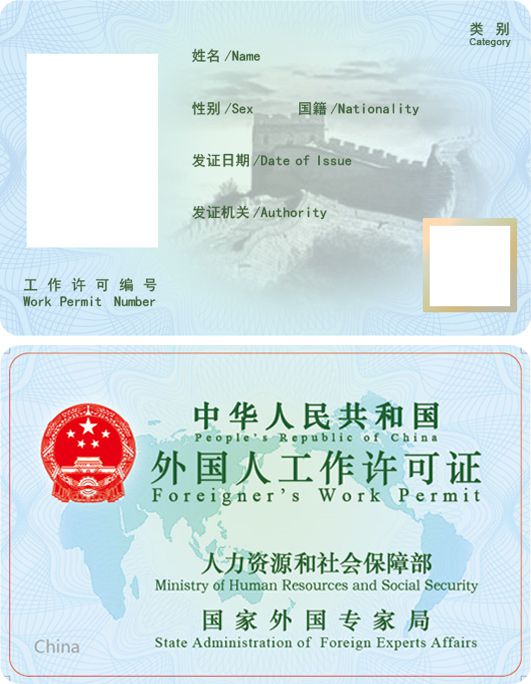Contents
Introduction:
With the continuous advancement of globalization, more and more foreign talents are choosing to work in China. Through this guide, you will learn every step, from obtaining a job offer to applying for a residence permit, such as how to comply with relevant Chinese laws to ensure legal residency and work. Whether it’s your first application or a renewal, this information will help you smoothly complete the process and avoid common application pitfalls. This article provides the latest procedures for applying for a Work Permit and Work Visa in China from 2025.
1. Detailed Steps for Obtaining the Chinese Work Visa (Z Visa)
The Work visa is the permit for foreign nationals to enter China, while the work permit is required after entry, allowing them to work and reside legally in China. First, foreign employees need to obtain a job offer from a Chinese employer. Secondly, once the employer has decided to hire a foreign employee, the employer must apply for a Work Permit Notification from the local labor department or relevant authority. This is an administrative process that the employer must handle, not the foreign employee.
Once the foreign employee receives the Work Permit Notification, they can use this document to apply for a Z Visa at the nearest Chinese embassy or consulate. At this stage, the foreign employee will need to provide a range of supporting materials, such as a valid passport, employment contract, medical examination certificate, etc.
Typically, the Chinese employer is responsible for submitting the work permit application via the Foreigners’ Work Permit Management System, while the foreign employee provides the necessary personal documents and information. Once the foreign employee receives the Z Visa, they can legally enter China. It is important to note that the Z Visa is usually a single-entry visa.
2. Process for Obtaining the Work Permit and Work Visa in China
Chinese Work Permit Application Process Before Entry
- Online Application: The Chinese employer must log in to the designated work permit management system, electronically submit relevant information about the foreign employee, and provide the necessary digital documents. These documents generally include the foreign employee’s employment contract, educational certificates, criminal record certificates, etc.
- Initial Online Review: The accepting authority will conduct a preliminary review of the submitted materials within 5 working days. If the materials are incomplete or do not meet the regulations, the applicant will receive an online notification for corrections. If corrections are not made within the specified time, the applicant may be required to submit physical documents by appointment.
- Acceptance: The competent authority, such as the State Administration of Foreign Experts Affairs (SAFEA) or the Human Resources and Social Security Bureau will decide whether to accept the application. If the application materials are complete and meet the regulations, the competent authority will immediately issue an acceptance receipt and proceed to the next review process.
- Review: The decision-making authority will review the application materials within 10 working days. The review will include verifying documents such as the original labor contract, work qualification certificate, criminal record certificate, medical examination certificate, and highest degree certificate.
- Decision: For applications that meet the requirements, the decision-making authority will issue an administrative permit and generate the Work Permit Notification online. Within 10 days of the decision, the Foreign Work Permit will be issued. This document allows the foreign employee to legally work in China.
After obtaining the Foreign Work Permit, the foreign employee can enter China with the Z Visa. Only after completing all these steps and obtaining the work permit can the foreign employee legally work in China.
Chinese Work Permit Application Process After Entry:
- Work Permit Application: Within 15 days after entry, foreign employees must apply for a work permit from the local labor bureau or human resources and social security bureau. This is necessary to ensure that the foreign employee can work legally in China, and obtaining the work permit is a crucial step in starting formal employment. This process requires submitting documents like the employment contract, health check certificates, educational and qualification certificates, etc. The specific requirements may vary based on the industry and position.
- Residence Permit Application: If the foreign employee’s work visa (Z Visa) is valid for more than 30 days, they must apply for a residence permit from the local public security exit-entry administration department within 15 days after entry.
Tips:
- The Z Visa is only a temporary entry visa for foreign employees to enter China. To work legally in China, the foreign employee must apply for a work permit and obtain a residence permit. Failure to apply for or renew the work visa and residence permit on time may result in the risk of illegal residence.
3. The Electronic Application Process: Work Permit and Work Visa in China
In 2025, the process for applying for Chinese work visas and work permits is gradually transitioning to an electronic system. Foreign employees can apply electronically through the Foreigners’ Work Permit Management System. Generally, this system is operated by Chinese companies because the system is designed to help employers submit applications and manage work permits and related matters for foreign employees. Foreign employees need to provide necessary documents and information, but the entire application and management process is handled by the Chinese company through the system. Main process description:
- Application Process: Through the system, the Chinese employer submits the foreign employee’s work permit application, including the employment contract, educational background, and work experience certificates. These materials are directly submitted to the relevant labor department for approval.
- Electronic Visa Application: For the Z Visa, the applicant can submit the visa application form and required documents online, reducing the traditional face-to-face application process.
- Electronic Tracking and Updates: Applicants can track their application progress in real-time on the electronic platform and get updated information on their work visa and residence permit. The Chinese employer is also responsible for maintaining the work permit’s renewal and update process.
Therefore, the assistance and operation of the employer are crucial when foreign employees apply for work permits and visas. Foreign employees need to work closely with their employers to ensure that all necessary documents and materials are submitted and processed on time. For example, foreign employees need to provide personal information, health checks, etc,. but the operation and submission of work permit notifications and related procedures are typically handled by the HR department of the employer.
Tips: Due to language barriers and some small Chinese companies, especially those without dedicated HR departments, the assistance and operation of the employer are particularly important when applying for work permits and visas. Foreign employees need to closely cooperate with their employers to ensure that all necessary documents and materials are submitted and processed on time. If the Chinese employer is a small company or a WFOE (Wholly Foreign-Owned Enterprise) with no HR department, it is advisable to consider outsourcing the process to a professional third-party company like GWBMA for handling the paperwork.
4. Categories of Chinese Work Permits: A, B, C
- Category A: High-End and Urgently Needed Talent: Suitable for foreign employees with high-end professional skills or those working in industries that are in short supply in China. Typically, Category A work permits apply to foreign managers, technical experts, researchers, etc.
- Requirements: Foreign employees typically need to have advanced degrees (such as a PhD) or significant professional experience.
- Advantages: The application process is streamlined, and foreign employees can obtain longer work permits and residence permits.
- Category B: General Professional Talent: Suitable for foreign employees who have certain skills or educational background but do not belong to high-end talent or urgently needed sectors. Category B is typically for middle managers, technical staff, language teachers, etc.
- Requirements: Foreign employees need at least a bachelor’s degree and some relevant work experience.
- Advantages: The application process is more standard, and foreign employees usually receive flexible work permits and residence permits.
- Category C: Short-Term and Low-Skill Workers: Category C work permits are for foreign employees working in China for short durations or in low-skill positions, such as short-term contract workers, interns, etc.
- Requirements: The requirements for Category C are more relaxed, with fewer demands on qualifications or work experience.
- Advantages: High flexibility, but the work permit’s validity is usually shorter.
4. Chinese Work Permit Scoring Standard
Points Allocation Table for Foreign Experts (Provisional Version)
| Scoring items | Standard | Score |
| Directly grant qualification | Selected into the domestic talent introduction program and meet internationally recognized professional achievement recognition standards | — |
| Encouraged job standards that meet market orientation | — | |
| Innovative and entrepreneurial talents and outstanding young talents | — | |
| Annual salary paid by domestic employer (10,000 RMB) Maximum score: 20 points | 45 and above | 20 |
| [35,45] | 17 | |
| [25,35] | 14 | |
| [15,25] | 11 | |
| [7,15] | 8 | |
| [5,7] | 5 | |
| Less than 5 | 0 | |
| Education level or vocational qualification certificate, etc. Up to 20 points | Doctorate; internationally recognized highest level professional skills qualification certificate or senior technician or equivalent | 20 |
| Master’s degree; technician or equivalent | 15 | |
| Bachelor’s degree; Senior engineer or equivalent | 10 | |
| The maximum number of points for this item is 20 | For each additional year exceeding 2 years, one point will be added. | Maximum 20 points |
| 2 years | 5 | |
| Less than two years | 0 | |
| Annual working hours: up to 15 points Unit: Month | 9 years of working time and above | 15 |
| [6,9] | 10 | |
| [3,6] | 5 | |
| Less than 3 | 0 | |
| The maximum score for Chinese proficiency is 5 points | Foreigners who once had Chinese nationality | 5 |
| Obtained a bachelor’s degree or above with Chinese as the teaching language | 5 | |
| Pass the Chinese Proficiency Test (HSK) Level 5 or above | 5 | |
| Pass the Chinese Proficiency Test (HSK) Level 4 | 4 | |
| Pass the Chinese Proficiency Test (HSK) Level 3 | 3 | |
| Pass the Chinese Proficiency Test (HSK) Level 2 | 2 | |
| Pass the Chinese Proficiency Test (HSK) Level 1 | 1 | |
| Work orientation: up to 10 points | Western Region | 10 |
| Old industrial bases such as the Northeast | 10 | |
| Special areas such as national poverty-stricken counties | 10 | |
| Age (years) Maximum score: 15 points | [18,25] | 10 |
| [26,45] | 15 | |
| [46,55] | 10 | |
| [56,60] | 5 | |
| More than 60 | 0 | |
| Graduated from a high-level university abroad or have working experience in Fortune 500 companies and other specified conditions. Up to 5 points for this item | Graduated from a high-level university abroad | 5 |
| Experience working for Fortune 500 companies | 5 | |
| With patents and other intellectual property rights | 5 | |
| Have worked in China for 5 years or more | 5 | |
| Local encouragement bonus points: up to 10 points | Special talents in short supply for local economic and social development (specific standards to be formulated by provincial foreign employment management departments) | 0-10 |
Conclusion:
With the continuous development of China in the era of AI and innovation, more and more foreign talents are choosing to work in China, becoming professionals in various fields. China is also increasingly welcoming to talented foreigners, encouraging more foreign experts to come. This is a change of the new era.



